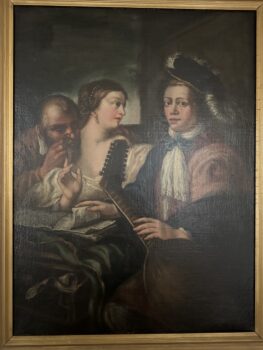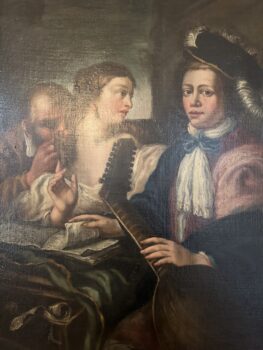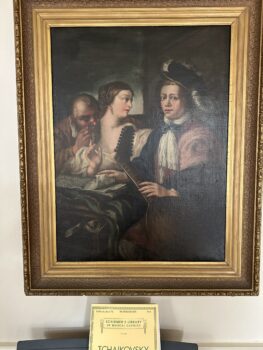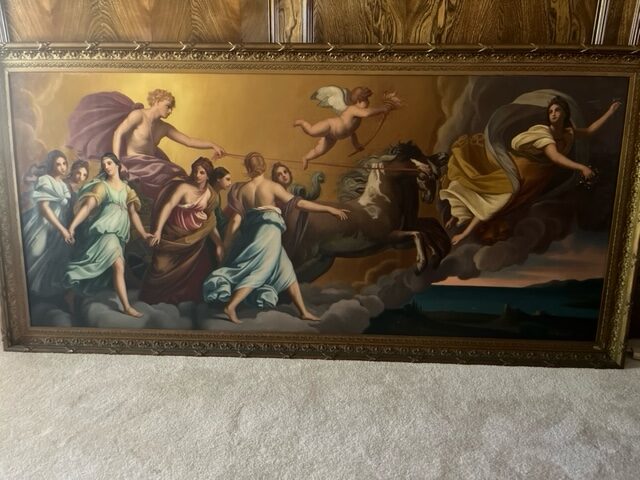Believe it is from a dutch painter mid 16th or 17th century based on the guitar (number of strings). Oils. Size approximately 24×32. No visible signature.
This art appraisal report offers an in-depth and impartial assessment of the artwork in question, grounded in the appraiser’s expertise and familiarity with the art market. All the information and data analyzed in this report is sourced solely from the client.
Having a clear understanding of the value of your artwork is crucial in making informed decisions about its future. This report provides a precise estimate of the value of each piece, using US dollars as the base currency. It is not intended to encourage the sale of the artwork, but rather to provide valuable information on how to proceed should the client decide to do so in the future.
Detailed description of the artwork, including its medium, dimensions, and condition.
Checking Originality: Identification with Artificial Intelligence Test
In the quest to identify a match, Image Search employs advanced AI techniques to scour databases of images in order to find visually similar images. This is achieved through the use of various algorithms such as pattern recognition and machine learning. While some results may be considered as “matches” due to a clear similarity, other results may be inconclusive as they rely more on chance rather than any specific similarities. To conduct this test, a front-facing image was used as a reference to search for similar images on the internet.
The results of the automatic recognition are not conclusive. If a match is found, it will be shown below:
What specific information can we obtain from this test?
Our findings demonstrate this is a unique work of art; the comparison images in our gallery could not be matched with it. Even though there is always some uncertainty, we’ve found that this method gives accurate results 90% of the time, so it’s a good way to start figuring out if something is real. To completely identify the artwork, I continue to the next test.
We can see some scenes are repeated throughout the results, which can be explained by the typical 17th-century costumes popular at that time.
Age estimation
In order to determine the age of the painting attributed to the listed artist Gerard van Honthorst, circa 17thC, one should look for several characteristics. First of all, the frame construction is a good indicator of age, as the frames of paintings produced during the 17th century were typically ornately carved and decorated. Additionally, the color palette used in the painting can also be a clue, as the shades and hues often changed throughout the centuries. For example, the use of darker, earthy tones in the painting may suggest it was created in the 17th century. Finally, the painting style and technique should be taken into consideration. The use of chiaroscuro (the contrast between light and dark) and the use of shadow and light to create a three-dimensional effect are common features of 17th century Dutch paintings. All these characteristics together can help determine the age of the painting attributed to the listed artist Gerard van Honthorst, circa 17thC.
Based on this information and the pictures provided, I can estimate this painting was made circa 17th Century.
Condition of the artwork
This painting attributed to the 17th century Dutch artist Gerard van Honthorst is in excellent condition. There is no need for restoration and no appreciable damages. Any minor damages present are minimal and do not detract from the overall aesthetic. This painting is a testament to the skill and craftsmanship of the artist, and is an excellent example of Dutch Baroque art.
Artist’s name, biographical information, artwork’s provenance (history of ownership) and exhibition history.
I study and research the signature of artwork to see if it matches any known signatures. In this case, the painting is unsigned so there is no way to authenticate or prove autorship of the scene.
I have attributed this painting to the listed artist, Gerard van Honthorst (Dutch: Gerrit van Honthorst; 4 November 1592 – 27 April 1656).Gerard van Honthorst was born in Utrecht, Netherlands in 1592 and is remembered as one of the most talented Dutch Golden Age painters of the 17th century. He was known for his skillful use of artificial light to create dramatic scenes, which earned him the nickname Gherardo delle Notti, or “Gerard of the Nights”. After visiting Rome in his early years and being influenced by the style of Caravaggio, he returned home and became a sought-after portrait painter. His works gained him fame and recognition for his skillful use of light, colour, and composition. He died in 1656 in Utrecht, leaving behind a legacy of beautiful Dutch art.
Detailed analysis of the artwork’s style, subject matter, and significance within the artist’s oeuvre and the broader art world.
I can check if the style and type of painting match those of the artist referenced.
A painting attributed to the artist Gerard van Honthorst, circa 17th century, is characterized by its bold brushstrokes, rich colors, and dramatic lighting. His use of chiaroscuro, or the contrast between light and dark, gives his paintings a dramatic and powerful atmosphere. He often uses strong contrasts of light and dark to create depth, and his paintings often have a luminous quality. His compositions are often balanced and structured, and his figures are often realistically depicted in a thoughtful, reserved manner.
Comparable sales information, including prices realized at recent auctions or private sales of similar works by the artist or in the same medium.
. In order to provide an up-to-date estimate of the fair market value for the original painting attributed to the Dutch artist Gerard van Honthorst, circa 17thC, I utilized the data collected, including auction prices and other relevant market information. This is crucial as it can be used in various contexts such as insurance, estate planning, and art market analysis. It also offers a valuable insight into how the valuation of the painting may have changed due to environmental or economic factors.
The auction prices were a significant factor in determining the current market value of the artwork, as they are based on actual transactions between buyers and sellers in the art market. As such, they are a strong indicator of the expected value of the piece in the near future.
By analyzing auction results from the last 6 months, I was able to accurately determine the current fair market value of the artwork. This approach provides a comprehensive view of how the value has changed over time and gives insight into any potential areas of appreciation or depreciation in its price. Additionally, it allows me to adjust my valuation as new auction prices become available.
Conclusion
Investing in art can be a great way to diversify your portfolio, as it is a tangible asset that can hold its value and appreciate over time. A piece of artwork attributed to an esteemed artist such as Gerard van Honthorst can be a particularly wise choice, as the artist's reputation and the piece's historical importance can increase the value of the artwork. Furthermore, art is an enjoyable asset that can bring joy and beauty to its owner. Buying an original painting by Gerard van Honthorst can be a great investment that is both financially sound and aesthetically pleasing.
The painting can be considered valuable by the art market because it is an original piece attributed to a highly acclaimed artist, the Dutch painter Gerard van Honthorst. Van Honthorst was a leading Baroque painter and was considered one of the greatest Caravaggisti, a style of painting originating from Italy. He had a successful career and was sought after by the courts of Europe, including those of England and Spain, for his work. Additionally, the painting is from the 17th century, a period of great artistic importance, and has survived to this day, making it a rare and highly collectible piece.
Final Appraisal Value ($)
20,000-25,000$
Appraisal Report made by:
Andrés Gómez
BSc, MSc, Expert Art Appraiser
10+ years of experience in Online Art Appraisals
100k+ Customers Served
Antique Store Owner
You can check my portofolio of past appraisals here:
https://www.appraisily.com/andres-portofolio/

Relevant photographs or supporting documentation, such as condition reports or expert opinions
A detailed summary of the appraisal process and the appraiser’s qualifications.
Mark-to-market art appraisal is a vital method for determining the current value of a piece of artwork. This form of valuation requires an appraiser to consider various factors, such as market conditions, the condition and age of the artwork, and the artist’s reputation. By taking all these elements into account, a mark-to-market art appraisal delivers an accurate assessment of a piece of artwork’s current market value.
The artist’s reputation, as determined by their track record in gallery and museum shows, awards, and other accomplishments, is also considered in mark-to-market art appraisal. Appraisers use this information to determine if the value of a piece is likely to increase or decrease over time. Additionally, they will inspect the condition of the artwork and note any signs of wear or damage that might affect its future resale value.
When performing mark-to-market art appraisals, appraisers also consider market conditions by researching current art market trends and comparable works that have recently sold. This information is used to provide an estimate of a piece’s worth at that point in time. By considering all of these factors, mark-to-market art appraisal is able to give a reliable indication of the current value of a work. This kind of valuation can also ensure fair prices are paid and received when buying or selling art.
In summary, mark-to-market art appraisal is a crucial tool for determining the true value of a piece of artwork, enabling buyers, sellers, and appraisers to make informed decisions regarding its worth. It takes into account multiple aspects to provide an accurate assessment of the current market value of a work. This information can be used to ensure that buyers and sellers are getting a fair price for the artwork, and that the appraiser’s valuation is up-to-date and reflective of current market conditions.
In the case of insurance replacement appraisals, mark-to-market art appraisals can also be used to accurately estimate the cost of replacing a lost or damaged artwork. The current value, as determined by the appraisal, is then used to determine the amount that the insurance company will pay back to the policyholder. This way, policyholders can rest assured that they will receive an appropriate sum for any artwork that needs to be replaced due to accidental damage or theft. Additionally, this kind of valuation helps insurers ensure they are not being overcharged when artwork needs to be replaced as part of a claim settlement.
The appraisal process is a thorough evaluation of the item or items in question. It involves researching and analyzing the information provided by the requester in order to provide an accurate estimate of its value. The appraiser takes into account factors such as condition, rarity, demand, and market prices. Photographs and detailed descriptions are especially important when providing an appraisal, since they help the appraiser identify any potential flaws or defects that could affect the item’s worth. By using all the resources that are available, an evaluation can be done quickly, efficiently, and with a high level of accuracy.
A statement of the appraiser’s liability and any potential conflicts of interest.
A qualified art appraisal, also known as a formal written evaluation, is a professional assessment of the monetary value of a piece of art by an individual who has specialized knowledge, expertise, and training in the field of art appraisal. This person must meet certain educational and professional requirements, including experience in researching and evaluating art, as well as knowledge of the art market and current market trends. The purpose of a qualified art appraisal is to provide an objective and unbiased opinion of the value of a piece of art for various purposes, including insurance claims, tax planning, estate planning, or to help determine a fair price for a sale or purchase.
We are committed to providing our clients with the most accurate and unbiased appraisal reports. To ensure impartiality, we adopt a flat rate, fixed fee structure for all appraisals, instead of a percentage-based fee. This eliminates any potential conflicts of interest between the art appraiser and the final report value. Our appraisal reports are in compliance with the Appraisal Foundation’s USPAP (Uniform Standards of Professional Appraisal Practice) standards and guidelines, which are widely accepted as the ethical and performance standards for appraisers. This guarantees that our reports are of high quality and legally defensible.
How to sell this artwork.
We have a structured guide to help you sell your artwork, you can find it here.









